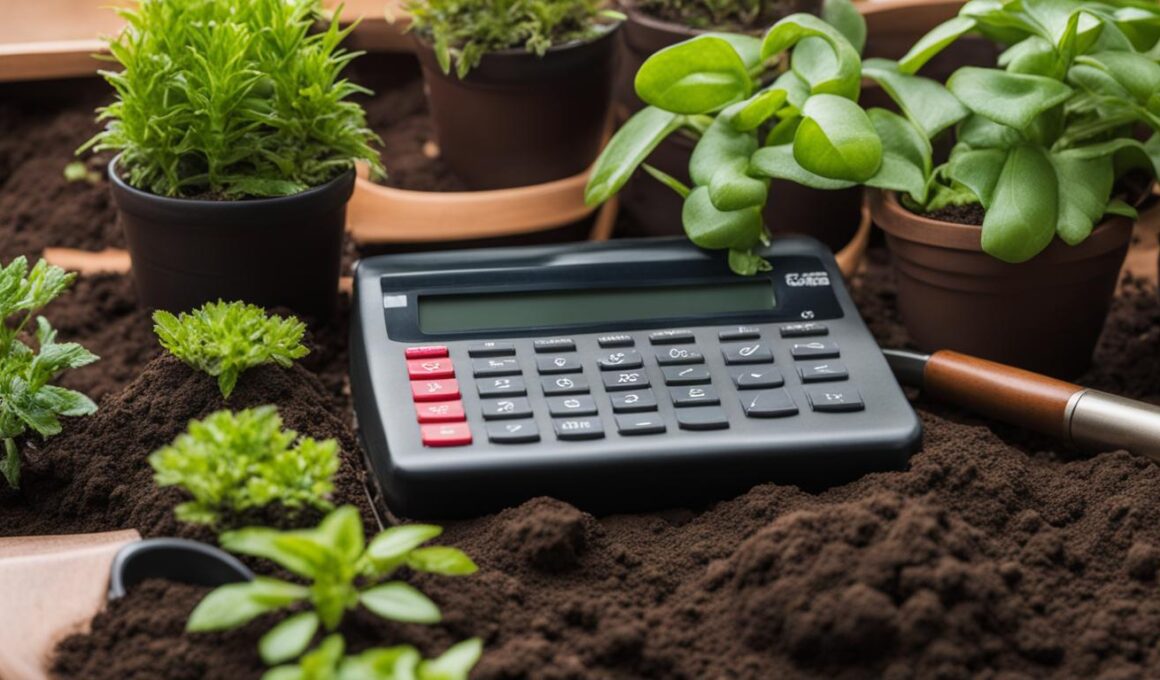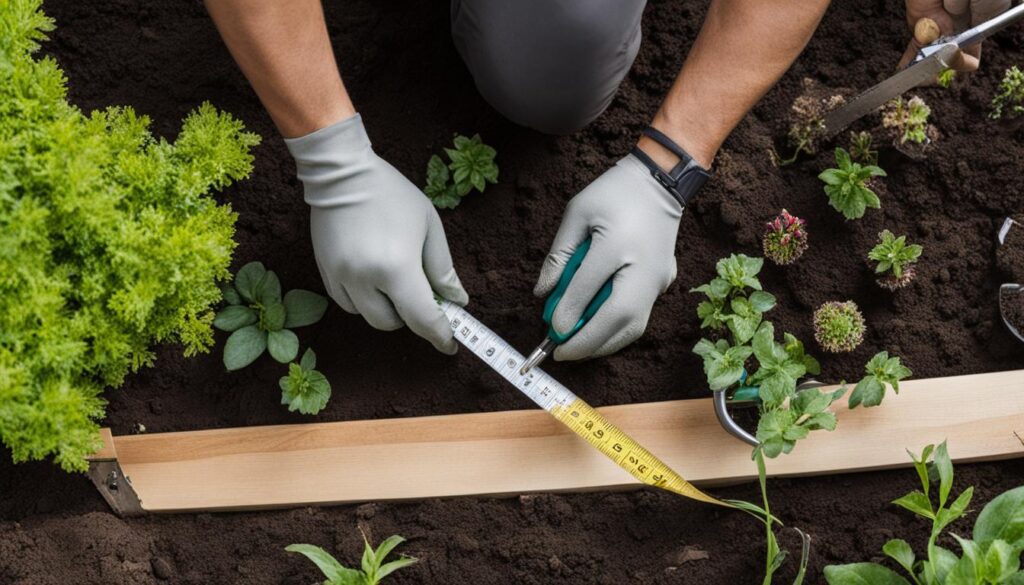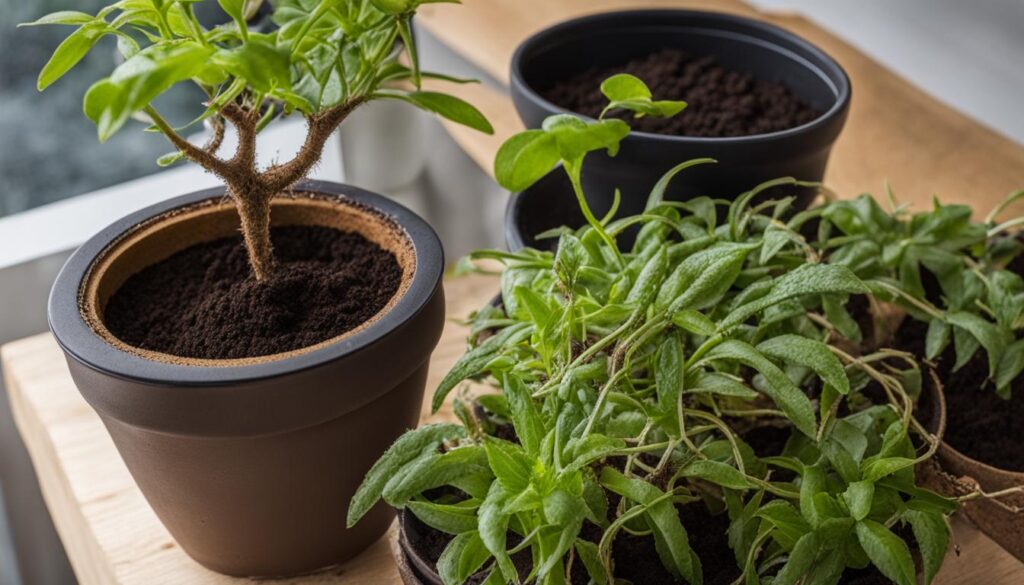One of the most important aspects of gardening is understanding how much soil plants need. Whether you’re starting a new garden or revamping an existing one, it’s crucial to determine the right amount of soil for your plants. This can be a challenging task for beginners and inexperienced gardeners. However, by using a soil calculator and understanding the measurements involved, you can ensure your plants have the appropriate amount of soil to support healthy growth.
Key Takeaways:
- Calculating the amount of soil required is essential for successful gardening.
- Measuring the area and depth of your garden accurately helps determine soil quantity.
- Using a soil calculator simplifies the process of calculating soil requirements.
- Proper soil depth and spacing are crucial for optimal plant growth.
- Raised bed height should be considered based on the rooting needs of your plants and your own accessibility.
Measuring the Area and Depth for Your Soil
Before calculating how much soil you need, it is important to accurately measure the area of your garden. For square or rectangular gardens, this is relatively easy. However, if you have a circular area, additional attention is required. To calculate the volume of soil required, use the formula A x B x Depth = M3. In order to ensure accurate calculations, measure the depth of soil based on the specific plants you want to grow. Most vegetable plants require a depth of 15-20 centimeters, while others like cabbage, carrots, peppers, and tomatoes may need deeper soil. Converting all measurements to the same unit, such as meters, will also help with accuracy.
Measuring the Area
When measuring the area of your garden, consider the following steps:
- For a square or rectangular garden, measure the length and width in meters.
- Multiply the length by the width to find the area in square meters.
- If you have a circular garden, measure the diameter and divide it by 2 to get the radius.
- Calculate the area using the formula π x (radius)^2, where π is approximately 3.14.
Measuring the Depth
When measuring the depth of soil, consider the specific requirements of your plants:
- Most vegetable plants require a depth of 15-20 centimeters.
- Deeper soil is needed for certain plants like cabbage, carrots, peppers, and tomatoes.
- If you are unsure about the depth requirements, consult a gardening guide or professional.
Calculating the Soil Quantity
Now that you have measured the area and depth required for your soil, it’s time to calculate the total quantity of soil needed for your garden. This step is crucial to ensure you purchase the right amount of soil and avoid any shortages or wastage. The calculation process is relatively straightforward, and it involves multiplying the area by the depth.
For example, let’s consider a rectangular bed measuring 10 meters in length and 4 meters in width, with a carrot depth of 30 centimeters. To calculate the soil quantity, you would multiply the length (10 meters) by the width (4 meters) and then multiply the result by the depth (0.3 meters):
Soil Quantity = 10m x 4m x 0.3m = 12 cubic meters
It’s important to note that different soil suppliers may list their prices per cubic meter. To determine the total cost of soil, you can multiply your soil requirement by the price per cubic meter. This will give you an accurate estimate of how much you can expect to spend on soil for your gardening project.
Key Points:
- Calculate the soil quantity by multiplying the area by the depth.
- Consider the specific measurements for your garden beds.
- Take note of the units used by different soil suppliers.
The Importance of Soil Depth and Plant Spacing for Optimal Plant Growth
When it comes to gardening success, understanding the importance of soil depth and plant spacing is crucial. These factors play a significant role in providing plants with the necessary environment for optimal growth and development. Let’s explore why soil depth and plant spacing are essential for your garden’s success.
Soil Depth and Nutrient Absorption

Plant Spacing and Air Circulation
Plant spacing is equally important for promoting healthy plant growth. Proper spacing allows for adequate air circulation between plants, reducing the risk of fungal diseases and promoting better overall plant health. When plants are too close together, it creates a crowded environment that hampers air movement and increases the likelihood of moisture buildup, which can lead to diseases. By following recommended plant spacing guidelines, you can create an optimal growth environment that allows for sufficient air circulation and helps prevent plant diseases.
Optimal Root Development and Easy Maintenance
In addition to nutrient absorption and air circulation, proper soil depth and plant spacing contribute to optimal root development and easy maintenance. When plants have enough soil depth, their roots can grow deep into the ground, providing stability and access to moisture. This helps plants withstand environmental stresses such as drought and wind. Adequate plant spacing also allows for easy access to individual plants for cultivation, watering, and maintenance tasks. By giving your plants the space they need to thrive, you can make gardening tasks more manageable and enjoy healthier, more robust plants.
Raised Bed Height Considerations
When it comes to raised bed gardening, one crucial factor to consider is the height of the bed. The height of your raised bed should be determined by the rooting requirements of the plants you plan to grow. Some plants have deep roots, while others have shallow roots, and providing the appropriate bed height is essential for their optimal growth.
If you’re planning to grow deep-rooted plants like artichokes or tomatoes, a raised bed with a height of 20 inches would be ideal. This allows the plants to establish strong root systems and access nutrients deep within the soil. On the other hand, shallow-rooted plants, such as arugula or lettuce, can thrive in a raised bed with a height of just 6 inches.
It’s not just the plants’ needs that should be considered when determining the raised bed height. Your own gardening accessibility is also an important factor. A taller raised bed can make it easier for individuals with limited mobility to tend to their plants without straining their backs or knees. So, if gardening accessibility is a concern for you, a taller raised bed may be the way to go.
Key Considerations for Raised Bed Height:
- Deep-rooted plants require taller raised beds, while shallow-rooted plants can thrive in shorter beds.
- Determining the rooting requirements of the plants you want to grow is crucial in choosing the appropriate raised bed height.
- Consider your own gardening accessibility needs and choose a raised bed height that allows for easy maintenance and cultivation.
Conclusion
In conclusion, the success of your gardening endeavors greatly depends on understanding the soil composition and providing optimal soil for your plants. By utilizing a reliable soil calculator, you can accurately determine the amount of soil your garden needs, ensuring proper nutrition and support for your plants’ growth.
Remember to consider the specific requirements of each plant, such as the depth of soil they need and the spacing between plants. Providing adequate depth allows for healthy root development, while sufficient spacing promotes optimal nutrient absorption and growth.
Furthermore, when using raised beds, selecting the appropriate height is crucial. Deep-rooted plants require taller beds, while shallow-rooted plants can thrive in lower heights. Taking your accessibility needs into account, choose a bed height that suits both your plants and your gardening comfort.
By carefully considering soil composition, using a soil calculator, and providing optimal conditions, you can achieve gardening success. With the right amount of soil, proper depth and spacing, and suitable raised bed height, you can create a thriving garden environment that will bring you joy and satisfaction.
How does the amount of soil needed for a 16 inch pot compare to the soil needs of different plants?
When comparing the amount of soil needed for a 16-inch pot with the soil needs of different plants, it’s important to consider the individual requirements of each plant. Some plants may require more soil to thrive, while others may do well with less. It’s important to research the specific needs of the plants you’re working with to ensure they have the right amount of soil for optimal growth.
FAQ
How do I measure the area and depth for my soil?
To measure the area, you need to accurately determine the length and width of your garden. For depth, consider the specific plants you want to grow and their recommended soil depth.
How can I calculate the total quantity of soil needed?
Multiply the area of your garden by the depth of soil required for your plants. This will give you the total volume of soil needed.
Why is the depth of soil important for plant growth?
Plants need enough room for their roots to grow and absorb nutrients and water. Insufficient soil volume can lead to stunted growth and decreased nutrient absorption.
What is the significance of spacing between plants?
Different vegetables and flowers have varying spacing requirements. Providing adequate space allows plants to thrive and allows for easy access for cultivation and maintenance.
How does raised bed height impact gardening?
The height of the raised bed should be determined by the rooting requirements of your plants. Some plants have deep roots and require a taller bed, while others can thrive in a lower bed height.










